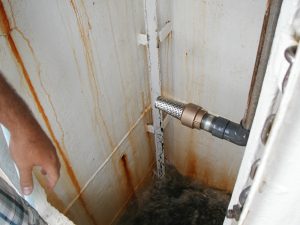Water Source and plumbing
Water typically enters a vessel from the “sea chest” or “Moon pool”, a rectangular or cylindrical recess in the hull of the vessel providing an intake reservoir from which the seawater is drawn. A metal grating separates the open ocean from the Sea chest, dampening the exchange of water and excluding large debris (centimeters) that might clog any downstream pump or plumbing. In order to measure properties with the in-line system that are as close to those in the water outside the ship, it is critical that the sea chest is clean and not inhabited by filter feeders. We note that this can be difficult to assess without inspection by diver.
Similar to the sea chest, plumbing needs to be cleaned prior to cruises, typically done by running bleach through pipes and hoses. Less time spent by seawater passing through the chest-pump-plumbing system leads to less opportunity to affect the particle absorbing and scattering properties. Consequently, we anticipate better agreement between in-line and in situ samples for short and wide pipes compared to long and narrow.

